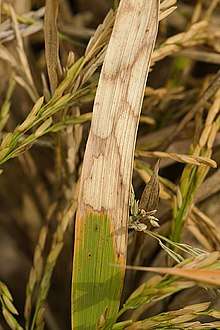Sheath blight of rice
Rice-sheath blight is a disease caused by Rhizoctonia solani (teleomorph is Thanetophorus cucumeris), a basidiomycete, that causes a major limitation on rice production in India and other countries of Asia,[1] it is also found to be a problem in the southern U.S. where rice is also produced.[2] This disease can cause yield decreases of up to 50% and cause a loss of quality.[3] Not only does it cause lesions on the rice plant, but it can also cause pre- and post-emergence seedling blight, banded leaf blight, panicle infection, and spotted seed.[4]

Disease cycle
Once a plant has been infected circular or oblong lesions that normally appear green-gray and water-soaked, are found on the lower leaves of rice, normally in the late tillering or early internode elongation stage of growth. The lesions then spread under favorable conditions of high humidity and low sunlight and reach the upper part of the rice plant using runner hyphae. When there is leaf dieback and sun can penetrate and dry the lesions, they turn tan with a brown border. The sclerotia are produced near the infection in about 6 days before falling off.[3] These can then survive in the soil, before being spread as the field is prepared or when it’s flooded for irrigation. The sclerotia can then come in contact with another plant and infect it.[5] Both the sclerotia and mycelia of Rhizoctonia solani overwinter in plant debris as well as in tropical environments where they can survive in weed hosts.[6]
Management
Cultural control
Not a lot of success has been found with breeding a resistant cultivar, but there are not many wild species of rice that have the resistance genes. It is widely thought that the resistance would be found in multiple genes or is controlled by quantitative trait loci, but not much has been found, so attempts at breeding resistance has been difficult.[7]
Biological control
Not much has been done, but there is the idea that the use of plant growth promoting rhizobacteria (PGPRs) could be a form of biological control. These have been used to help with both plant growth and with helping control other soil residing bacteria, and have been seen to control bacterial pathogens by competing for space and nutrients, as well as activating plant defense mechanisms.[7] Studies have shown that some strains of bacteria, when they’re applied to the rice seed before it’s planted, decrease the viability of the sclerotia of R. solani, reducing instances of disease and increasing yield.[1] Some species of potential antagonists that could become biocontrol agents are a few strains of Pseudomonas fluorescens that inhibit the mycelial growth and sclerotia germination.[1]
Chemical control
The main control method of sheath blight is through the use of both systemic and nonsystemic fungicides, of which the systemic are seen to be more effective. The use of this method of control allows fewer instances of disease, less inoculum and better yields. One of the chemical controls used often is azoxystrobin, a QOI that prevents the respiration of fungi.[8]
Resistant cultivars of plants have not been found and cultural controls are impractical, so chemical control is currently the best option in terms of controlling this disease.[9]
Pathogenesis
Once the rice sheath has been inoculated the pathogen forms an appressorium and infection cushions. Both intercellular and intracellular hyphae are formed in both the epidermal and mesophyll cells. The pathogen then releases many cell wall degrading enzymes (CWDEs) that contribute to lesion formation and spreading, some of those are polygalacturonase, cellulase, pectin methylgalacturonase, and polygalacturonic acid trans-eliminase. The ShB pathogen also produces toxins that inhibit rice radicle growth and wilting of the leaves. The main contributors to pathogenesis by the ShB pathogen, is from secreted hormones, Cytochrome P450s (a family of enzymes that is involved in the biosynthesis of plant hormones[10]), and growth hormones.[11]
References
- Devi, T. Vasantha; Vizhi, R. Malar; Sakthivel, N.; Gnanamanickam, S. S. (Oct 1989). "Biological control of sheath-blight of rice in india with antagonistic bacteria". Plant and Soil. 119 (2): 325–330. doi:10.1007/BF02370425. ISSN 0032-079X.
- Jones, R. K. (1989). "Characterization and Pathogenicity of Rhizoctonia spp. Isolated from Rice, Soybean, and Other Crops Grown in Rotation with Rice in Texas". Plant Disease. 73 (12): 1004. doi:10.1094/pd-73-1004. ISSN 0191-2917.
- Lee, Fleet N. (1983). "Rice Sheath Blight: A Major Rice Disease". Plant Disease. 67 (7): 829. doi:10.1094/pd-67-829. ISSN 0191-2917.
- Kumar, Dharmendra; Amaresh Gouda, S. (July 2018). "Evaluation of mycoparasitic efficacy of nematode-trapping fungi against Rhizoctonia solani inciting sheath blight disease in rice (Oryza sativa L.)". Biological Control. 122: 31–40. doi:10.1016/j.biocontrol.2018.04.003. ISSN 1049-9644.
- G., R.V.; Webster, Robert K.; Gunnell, Pamela S. (Nov 1992). "Compendium of Rice Diseases". Mycologia. 84 (6): 953. doi:10.2307/3760308. ISSN 0027-5514. JSTOR 3760308.
- Vijay Krishna Kumar, K.; Yellareddygari, S.K.R.; Reddy, M.S.; Kloepper, J.W.; Lawrence, K.S.; Zhou, X.G.; Sudini, H.; Groth, D.E.; Krishnam Raju, S.; Miller, M.E. (Mar 2012). "Efficacy of Bacillus subtilis MBI 600 Against Sheath Blight Caused by Rhizoctonia solani and on Growth and Yield of Rice" (PDF). Rice Science. 19 (1): 55–63. doi:10.1016/s1672-6308(12)60021-3. ISSN 1672-6308.
- "Rice Sheath Blight: A Review of Disease and Pathogen Management Approaches". Journal of Plant Pathology & Microbiology.
- "Rice Sheath Blight". Rice Sheath Blight. Retrieved 2019-12-15.
- Hashiba, Teruyoshi; Kobayashi, Takashi (1996), "Rice Diseases Incited by Rhizoctonia Species", Rhizoctonia Species: Taxonomy, Molecular Biology, Ecology, Pathology and Disease Control, Springer Netherlands, pp. 331–340, doi:10.1007/978-94-017-2901-7_30, ISBN 978-90-481-4597-3
- Kim, G.-T.; Tsukaya, H. (2002). "Regulation of the biosynthesis of plant hormones by cytochrome P450s". Journal of Plant Research. 115 (3): 169–77. doi:10.1007/s102650200022. PMID 12579366. S2CID 1267602.
- Zheng, Aiping; Lin, Runmao; Zhang, Danhua; Qin, Peigang; Xu, Lizhi; Ai, Peng; Ding, Lei; Wang, Yanran; Chen, Yao; Liu, Yao; Sun, Zhigang (2013-01-29). "The evolution and pathogenic mechanisms of the rice sheath blight pathogen". Nature Communications. 4 (1): 1424. Bibcode:2013NatCo...4.1424Z. doi:10.1038/ncomms2427. ISSN 2041-1723. PMC 3562461. PMID 23361014.